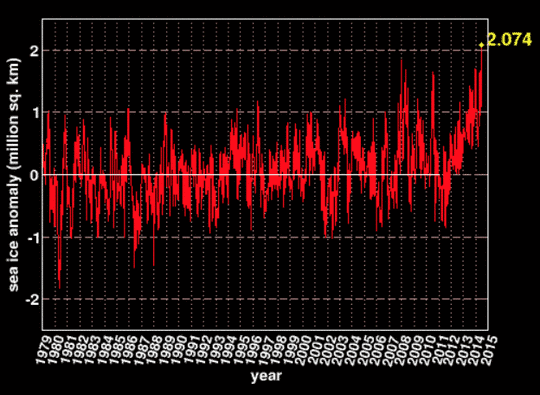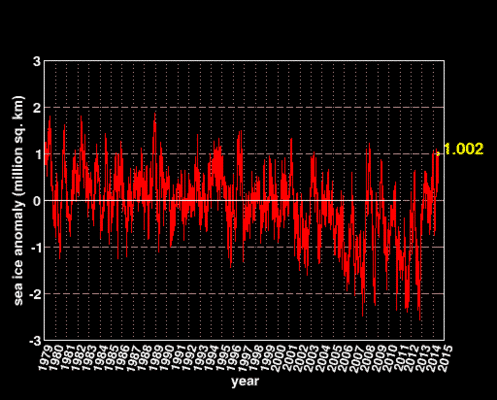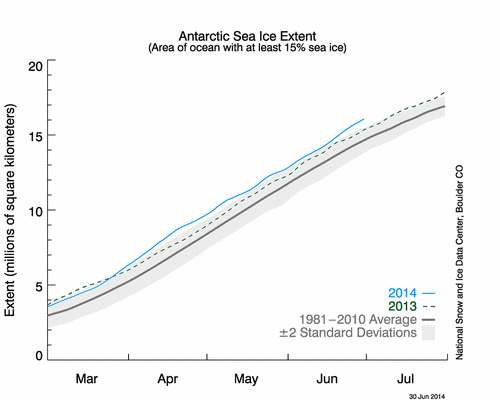Neuer Meereis-Rekord in der Antarktis
Die neue Rekord-Anomalie des Meereises der Südhemisphäre, also das die Antarktis umgebende Meereis, beläuft sich im Juni 2014 auf 2,074 Millionen km², also mehr als 2 Millionen km2 über dem langjährigen Mittelwert (University of Illinois; hier (Cryosphere Today) – Abbildung 1 :

Abb. 1 : Meereis-Fläche der Antarktis (Juni 2014)
Die bisherige Rekordmarke der Anomalie auf der Südhemisphäre liegt bei 1,840 Millionen km² und wurde 2007 erreicht.
Auch die globale Ausdehnung des Meereises (Arktis und Antarktis) lag am 29.06.2014 um 1,005 Millionen km² über dem Mittelwert.

Abb. 2 : Meereis-Fläche global (Antarktis + Arktis Juni 2014)
Hier findet sich diese ergänzende, vielleicht noch anschaulichere Darstellung:

Abb. 3 : Meereis-Fläche Antarktis
Dieser Eis-Befund paßt weder zu den Prognosen der Klima-Modelle, noch zur medialen "Eisschmelz- und Erwärmungs-Panik". D a h e r :
Weder den deutschen Medien noch den Klima-Instituten ist dieser neue antarktische und zugleich globale Eis-Rekord eine Verlautbarung wert !?
=================================================================
Anmerkung der EIKE-Redaktion (1) :
Dieser Artikel erschien zuerst auf: http://wattsupwiththat.com/2014/06/29/antarctica-sets-new-record-for-sea-ice-area/ ; Ergänzungen EIKE-Redaktion.
Wir danken für die Übernahme-Genehmigung.
Mehr: http://talkingabouttheweather.wordpress.com/2014/06/29/antarctica-sets-new-record-for-sea-ice/ und http://wattsupwiththat.com/reference-pages/sea-ice-page/
================================================================
Anmerkung der EIKE-Redaktion (2) :
Soeben wurde eine umfangreiche Übersichts-Arbeit publiziert, die sich mit den Temperatur-Trends rund um die Antarktis beschäftigt:
Another Antarctic sea ice record set – but excuses abound
Dort sind zahlreiche sehr anschauliche Abbildungen erläutert, z.B.:

Fig 2
The red box: I have inserted the red box 73S-63S 220W-50E because this area will be used in the following to evaluate the situation in the ice forming waters around Antarctica.
Zusammenfassend wird festgestellt:
Data suggest some cooling, certainly not warming.
Thus it seems that recent years for the area of ice formation around Antarctica show:
A: Decrease in Sea surface temperatures
B: Decrease in Air temperatures
C: Growth in Sea ice
..und abschließend:
Conclusion:
The conventional data sources like SST, MAT suggest that the bulk of the ocean surface mass is cooling in recent years accompanied by faster ice growth. Arguments based on Ozone or Salinity or precipitation appears not to be linked to the record levels of sea ice formation around Antarctica.
It is therefore fair to say the obvious:
* * * It’s getting colder around Antarctica and so the ice is growing * * *
====================================================